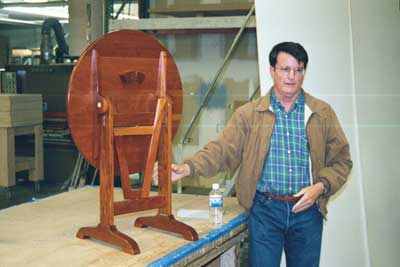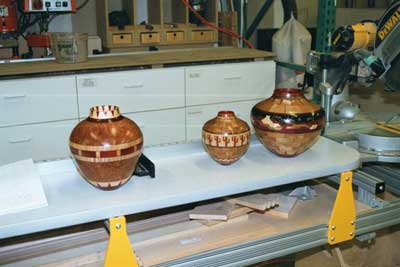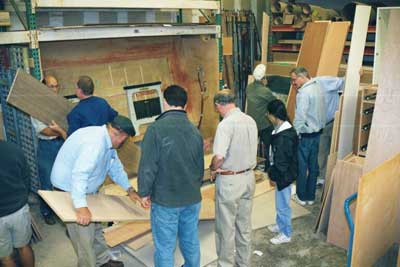
Last meeting
![]()
As we entered the Bartlett Cabinetry shop in San Francisco, the huge woodworking machines that we did not recognize puzzled us. Our host Lyle Bartlett started our "Tech Talk" with a little of his background and then conducted a tour of this wonderland. Lyle came from Idaho and started woodworking in a co-op shop. He learned a lot from the other members of the co-op. In 1989, he opened a shop of his own of 6,000 square feet. To reduce expenses and finish projects more quickly, he bought his first machine, which is now a "dinosaur." He started the tour by showing us his $150,000 Routech Record machine that looked like an aircraft simulator. A moving cab encased in a plastic compartment with a viewing window equipped with 12 tools can take a 4 X 8 sheet (or larger or smaller) held down by a vacuum and rout, drill and cut the sheet to specifications that are programmed into the computer. The wood is stationary while the cab with the cutters moves in both directions as it does its work. The demonstration showed a 4X8 sheet being cut into 6 panels with holes drilled for slides and panels. This will then be put together to make cabinets.

The machine can also cut elaborate panels with an intricate design, which can be round, oval or any shape imaginable. The sheets have to be of very accurate thickness because the machine measures each cut based on the thickness of the material. So he uses J-COR or ORA plywood which has very accurate thickness across the sheet. The machine once programmed for the design can optimize the cuts so there is very little waste. There are many types of cutters each in its own holder. They have to be "miked" into the holder very precisely for an accurate cut. The sections are not sawed apart but routed and leave a paper-thin trace of wood between the sections and then can easily be separated. Several problems can occur. A cutter can snap off and be sent flying. Luckily in his case, it went sideways and not near him. There can be a computer glitch or a bad computer program. He has seen cabs in other shops with holes in all directions. He learns from taking training at the Georgia Tech Wood Institute and from other shop owners with similar machines. Lyle also showed us a sophisticated edge banding machine which can adhere wood, plastic and other materials and does roundovers too. Then there was a wide belt sander that can sand up to 52 inches with 3 belts. He had 80/120/180 grit in the machine. He can also put in a 60 grit and use just that grit for heavy removal. We saw many more very sophisticated machines including a laser-guided rip saw.
Reports
Gene Wagg commended Arnold Champagne for giving BAWA $30 from the tuition he collects from his classes. Connie Voos reminded everybody about the September 19th party and that she needs $15/person to start buying things for the party. See the This & That column for all the details. Don Naples asked for members to give him input for a display case that he will build to display our treasured wood items at the November Woodworking show. He can be reached at d419naples@attbi.com or at 707/433-5234. He added that Ron Slayen will donate the funds to buy the materials. Thank you Ron, that is very generous. Arnie Champagne said that people like to see demonstrations at the booth at the show. So if people staffing the booth could arrange to plane something that they are working on or cutting dovetails or veneers or use a scroll saw, it would help draw spectators and possible members. Here is where we get most of our new members.
Guests & New Members
Three people identified themselves and who all had taken classes from Arnold. Jeremy Ashley of San Francisco, Joyce Fukuman of San Jose and Bobbi Meserve of Sunnyvale. Welcome to all.
Show & Tell
Neal White showed a vinyard table from the new Taunton Press book "Dining Tables". Neal has a few copies of the book he'll sell to club members at his author's price.

Main Presentation
Linda Salter our Past President gave us a little background on herself. She, her husband and son built their own house about 25 years ago. This got her started in woodworking and first concentrated on carving carousel animals. She also made band saw boxes, children's puzzles using a scroll saw and other items which she sold at street fairs. Getting tired of sanding and re-sawing, she turned to wood turning. Last year she started doing segmented bowls and there she was back to sanding and sawing. She started with a slide show of her work. Then she gave us a blow by blow explanation of how she makes these stunning segmented bowls. Some of these bowls have over 700 pieces of various woods. Her example was a Southwest design bowl that she has made.

Planning is extremely important. Using Excel that has squares across the page, she draws the design and colors in the various squares. Then she uses a bowl profile cutout to put over the design to see how it looks. After carefully selecting the various woods with the colors she would like to use. She planes the wood, then joints, then rips to width and finally planes to height. The bowl is basically a series of rings of segmented pieces placed on top of each other to achieve a design. She then cuts the pieces and glues them into strips. Then she is ready to cut segments at the proper angle to form a round ring. The angle is very important and she gave us a chart that took the geometry out of the process. She has a very accurate miter fence to get the proper angle. She forms the ring and clamps it with a hose clamp and checks carefully for gaps. If needed, she has to lightly sand each piece using a jig to remove the gaps. Titebond dries too quickly since she has to glue so many pieces together so she uses CA glue and floods the surface while the ring is still in the hose clamp. With Hot Melt glue, she attaches the ring to a faceplate and sands it flat. She works from both the top and bottom of the bowl in two separate glue ups, gluing the rings to each other. Her husband made a press for her to use. Once dry, she puts the two sections together using Scotch Adhesive Transfer tape and does a rough turning of the outside. She then takes them apart and turns the inside and sands to a final finish. She then glues the two pieces together and finishes turning the outside. Also cuts away any lump or glue on the inside at the seam where she joined the pieces together. The finish is Deft spray lacquer onto a rag and wiped on followed by paste wax. That was a fine presentation and we are now all experts on how to make segmented bowls (after 1 or 2 years of practice) or we can give the wood pieces to Lyle Bartlett. He can put them into his machine and out will pop a finished segmented bowl. At the end of Linda's presentation, Lyle announced that there were scraps available to take home. After a near riot, the significant pile whittled down quickly.

Full of the great munchies that Lyle had prepared and coupled with our own hospitality goodies and giddy from seeing all that sophisticated machinery and with all the new found knowledge about segmented turning, we staggered home bearing our scrap wood with us. Unfortunately, we forgot about Peter Wronsky's Silent Auction item of a large piece of Apiton. A very hard and dense wood.
Thank you, Lyle and Linda. Peter, bring back the Apiton wood.